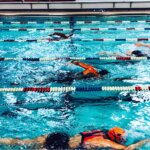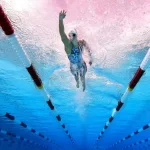When you’re training for a triathlon, swim drills are a great way to improve your swimming technique and prevent injury. They’re also a good way to focus on specific areas of your stroke, or even just get in some extra training if you have time. Not only will swim drills make you physically stronger, but they will also help build up your endurance, allowing you to swim stronger for longer periods of time.
Take a look at these 6 swim drills that triathletes can use in their workouts:
1. The One-Arm Drill
The one-arm drill is a great way to learn how to use both arms in a normal stroke. This is important because it will make you more efficient, and therefore faster. The one-arm drill is also good for triathletes, who need to swim using their non-dominant arm as well as their dominant arm.
In the one-arm drill, you swim with your non-dominant hand out of the water and only pull with your dominant hand (the opposite side from which you breathe). You do this for 10 strokes, then switch hands for another 10 strokes.
2. The Finger Drag Drill
The finger drag drill helps you focus on keeping your elbow high and recovering your hand outside your head and into the water sooner. To practice this, swim down to a depth of about four feet and make a few strokes with your arms in front of you. Then, pick up the pace so that you’re doing 10-15 strokes per one breath. When it comes time for another breath, pause at the surface long enough to take a big inhale, then start swimming again while keeping both hands straight out in front of your body. When they get too far away from their bodies or begin to sink below their heads, quickly turn them over (pivot on those wrists) so that they’re palms face downward and start moving forward again with armstrokes.
3. The Fist Drill
The fist drill helps you learn to keep your forearm perpendicular to the water when punching forward. This will help you achieve a clean catch in the water and avoid pulling too much water into your mouth.
To do this drill, swim with one arm extended out in front of you and then slowly bring it back towards your body without letting anything rotate (elbow or forearm). Keep moving both arms slowly until they’re back at their starting position above your head, then repeat with the other arm.
It’s important to remember that this is a very slow drill so that you can focus on keeping everything steady right before catching each breath.
4. The 6-3-6 Drill
The 6-3-6 drill can help you find problems with your body rotation by exaggerating how early and often you rotate.
This is a simple drill that can help you find problems with your body rotation. Begin by swimming the first half of the pool in freestyle, then change to breaststroke for the second half. Your goal is to match your stroke rate and time between breaths (6 kicks per arm cycle) during each half of this stroke pair.
If you have trouble matching these metrics, try using a pull buoy in place of a kickboard when doing this drill next time. This will allow you to rotate more freely while still getting the benefit of an added stabilization element from holding onto something overhead.
5. The Head-up Front Crawl
The Head-up Front Crawl is an excellent swim drill for sighting and watching your hand entry.
Here’s how to do it: Keep your chin on the surface of the water and swim full stroke front crawl. Practice keeping your head still by focussing on a point at the end of the pool. If your head stays still then you’re far more likely to stay in a straight line, especially when you then transfer your swimming from the pool to the open water.
Make sure that your fingertips go in first rather than slapping the water or the heel of your palm. You can also make sure that the first action once you extend your arm is to bend your elbow out to the side and push your forearm down to get hold of the water. This can be a challenging, yet effective drill.
6. The Catch-Up Drill
The catch-up drill can help you lengthen and smooth out your stroke by synchronizing both arms. At its core, the catch-up drill is a good way to practice your stroke. It allows you to lengthen and smooth out your strokes while synchronizing both arms.
To perform the catch-up drill, swim with one arm at a time while the other points downward with only its fingertips in contact with water. When you make any part of your body touch another part (such as one hand touching another), switch arms and repeat for 20 yards (18 meters). For an extra challenge, try doing this for 100 yards (91 meters) without stopping or touching the wall.
As a triathlete, you spend a lot of time training in the pool. That means that when it comes to your swimming technique, you need to be consistent. Swim drills can help you improve stroke efficiency and prevent injury, so make sure to include them in your training routine. These drills will make you stronger and help build up endurance for race day.
Looking for more drills to help you train for race day? Contact me today to customize a training program to prepare you for your upcoming race!
Train Right, Tri Right,
Coach MJ







